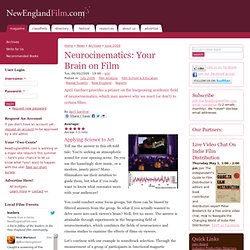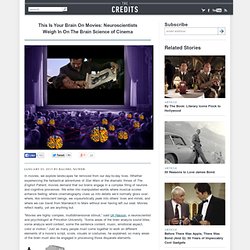

Neurocinematics: When Neuroscience Meets Filmmaking. While I was in Berlin, I had the opportunity to attend a talk at the Deutsche Guggenheim about the recent researches made in neuroscience to understand how much control a given film has upon viewers’ brain activity.

The talk was given by Professor Uri Hasson (Neuroscience Institute, Princeton University) and film director Amos Gitai (Israel). It was organized by the Association of Neuroesthetics in collaboration with the Berlin School of Mind and Brain and the Institut für Raumexperimente (Studio Olafur Eliasson). -> The presentation of Professor Uri Hasson was fascinating (see this article from the New Scientist). By using fMRI and observing brain activity, it is now possible to tell if two spectators go through similar mental states when watching a movie: do they pay attention to the same things (e.g. a face or a decor); do they experience the same picks? The film director Amos Gitai didn’t let it pass. For my part, I think that we cannot ignore the evolution of science.
Overview of neurocinematics, 07/09. Applying Science to Art Tell me the answer to this oft-told tale: You’re seeking an atmospheric sound for your opening scene.

Do you use the hauntingly slow music, or a modern, jaunty piece? Many filmmakers use their intuition to guide them, but what if you really want to know what resonates more with your audiences? You could conduct some focus groups, but those can be biased by filtered answers from the group. So what if you actually wanted to delve more into each viewer’s brain? Let’s continue with our example in soundtrack selection. This computational method of research is called intersubject correlation; its aim is to determine which areas of the brain are activated by specific film sequences. So Hitchcock fans rejoice -- he may never have earned an Oscar, but he has demonstratively shown his masterful control of our brains as we contemplate the suspense in his work (even if it was through his comparatively low involvement in the television series).
Applying Art to Science. Rise of Neurocinema: How Hollywood Studios Harness Your Brainwaves to Win Oscars. One thing you aren't likely to hear Sunday night from the Oscar-winning producer after accepting the trophy for Best Picture: "I'd like to thank my neuroscience partners who helped us enhance the film's script, characters, and scenes.

" It's not that far-fetched, though. A sizable number of neuromarketing companies already brain test movie trailers for the major studios through fMRI, EEG, galvanic skin response, eye-tracking and other biometric approaches. For now, the test data helps the studios and distributors better market the movie. But what about using brain feedback to help make the movie? A trailblazing few firms and studios have delved into the upstart practice of "neurocinema," the method of using neurofeedback to help moviemakers vet and refine film elements such as scripts, characters, plots, scenes, and effects.
Stephen Susco, who wrote the $187 million grossing horror movie Grudge, is not a practitioner of neurocinema. Other filmmakers seem divided. This Is Your Brain On Movies: Neuroscientists Weigh In On The Brain Science of Cinema. In movies, we explore landscapes far removed from our day-to-day lives.

Whether experiencing the fantastical adventures of Star Wars or the dramatic throes of The English Patient, movies demand that our brains engage in a complex firing of neurons and cognitive processes. We enter into manipulated worlds where musical scores enhance feeling; where cinematography clues us into details we’d normally gloss over; where, like omniscient beings, we voyeuristically peek into others’ lives and minds; and where we can travel from Marrakech to Mars without ever having left our seat. Movies reflect reality, yet are anything but. “Movies are highly complex, multidimensional stimuli,” said Uri Hasson, a neuroscientist and psychologist at Princeton University.
“Some areas of the brain analyze sound bites, some analyze word context, some the sentence content, music, emotional aspect, color or motion.” Viewers, those early researchers reasoned, must not be able to detect continuity errors in movies. Pdf/Neurocinematics-Projections2008.pdf.